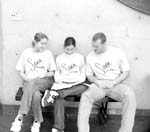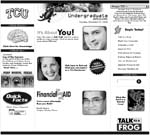SGA candidates begin campaign
Three of five positions go unopposed for Nov.
14 House, PC elections
By Hemi Ahluwalia
staff reporter
Filing for elected positions in Student Government Association ended midnight Tuesday with only seven candidates running for five available positions.
Three of the five positions available in SGA are unopposed: Sara Donaldson, a junior neuroscience major, will run for SGA president; Amy Render, a sophomore marketing major, will run for vice president of the House of Student Representatives; and Sara Komenda, a sophomore biology major, will be running for vice president of Programming Council.
The House secretary position will be contested by Kaylan Minor, a sophomore environmental science major, and Ryan Shoemake, a junior theater major. Deanna Bennett, a junior finance and accounting major, and John Billingsley, a sophomore business major, will run against each other for treasurer of House.
Candidates have seven days to campaign and encourage the student body to vote on Nov. 14.
Having so many important positions that are unopposed is very unusual, said Brian Becker, elections and regulations committee chairman.
“Normally, the positions of president and vice president (will) have multiple candidates while the positions of secretary and treasurers would be the positions to only have one candidate,” Becker said.
Larry Markley, SGA advisor, said the lack of candidates may be due to a general apathy toward House and PC.
“There are various factors that could have contributed towards the lack of interest, but I believe that SGA has not done a good enough job of informing the student body of what is going on and if there are any positions available to run for,” Markley said. “I also think that the restructuring referendum failing was also a major factor because it caused a lot of students who would have run to be ineligible.”
A student referendum was held Oct. 26 to change eligibility requirements and duties of executive positions in SGA. The referendum, which needed a two-thirds majority (about 67 percent), failed when only 62 percent voted in favor of it.
 |
|
Hemi Ahluwalia/STAFF REPORTER
Kristin Scott, a junior fashion marketing major; Sarah Jetter, a junior Spanish major; and B.J. Roberts, a junior finance major, look over some campaign literature about Sara Donaldson, Student Government Association presidential candidate, outside Moudy Building North Tuesday. As of the Tuesday midnight deadline, only seven people had applied to run for an elected office in SGA. |
Still, some students say the small amount of candidates on the ballot may not keep students from voting in the SGA election.
“I will still vote in this election because the candidates still need to receive votes and I would like to exercise my right to vote,” said Sarah Jetter, a junior Spanish major.
Some unopposed candidates still plan on campaigning despite being the
only one running for the position.
“I will probably do more of my campaigning by person now so I can
make sure that the students know that they need to vote,” Donaldson
said. “I will go around to the different organizations on campus
to let them know that I am running and that ‘moving forward’
is my campaign slogan.”
Donaldson is not the only candidate who will be doing most of her campaigning in person. Minor also plans to make this election campaign a more personal one.
“You are not going to see my name plastered all over campus,” Minor said. “Instead, I am going to take a more personal approach to this campaign.”
The weather may also play an important role in how many yard signs and posters students see around campus this semester.
“We only have a small amount of money to use and I do not want to waste it on posters if the weather will be bad all week,” Donaldson said.
Each candidate is allowed to use no more than $200 during regular elections and no more than $50 during runoffs, Becker said.
“The candidates are required to turn in all receipts of all items that they purchased or a list of what the fair market value is for items that were used but were not bought,” Becker said.
Hemi Ahluwalia
hemia@hotmail.com
Admissions Web site gets redesigned
Designers say goal is to make site more appealing
By Emily Ward
staff reporter
Armed with a load of work and only five weeks time, Victor Neil, David Van Meter and Phil Henslee teamed up to redesign the TCU undergraduate admissions Web site in early September.
The Web site (www.admissions.tcu.edu) was launched Oct. 13, three days before the goal date.
“We basically realized that the old site was nothing but information and links that left a lot of unanswered questions,” said Van Meter, editor of the TCU Magazine. “So our goal was to make the new Web site more compelling, and I feel that we have met that goal.”
Highlights on the new site include a link to information about Fort Worth, a “What’s Up” TCU news link and “Frog Brain,” an interactive link that displays random facts about TCU and other areas of interest.
Students can also download a portable document form file of TCU’s undergraduate admissions application off of the new Web site. After downloading the file, students can print the application, fill it out and send it in to the university.
 |
|
The redesigned TCU undergraduate
admissions Web site, (www.admissions.tcu.edu),
was launched Oct. 13. It highlights a link to information about
Fort Worth, a “What’s Up” TCU news link and “Frog
Brain,” an interactive link that displays random facts about
TCU and other areas of interest.
|
“We are working on a true online application that can be filled out and sent in to a database all through the Internet,” said Neil, director of new media at TCU.
The overall philosophy of the new Web site is to make it seem young but professional, Van Meter said. The site’s average viewer is usually between the ages of 17 to 24, he said.
Every four out of five prospective students use the Internet when looking at different colleges, said Neil. Students are looking for sites that are both appealing and informative, and the new Web site was designed mainly with them in mind, he said.
“It looks very appealing and it shows a lot of school spirit,”
said Karen Sawyer, a freshman premajor.
Sawyer said when she was comparing colleges, she spent a lot of time looking
at different universities’ Web sites. She said TCU’s new admissions
site would be better if it had more links to topics such as Frog Camp.
Neil said most of the links were designed to make the site more interactive and engaging.
Students are looking for something more hip and appealing, Neil said. If they can become interested when looking at the Web site, the more likely they are to remember TCU when viewing other schools’ Web sites, he said.
Before work on the new Web site began, the designers researched those sites from leading schools around the nation, Van Meter said.
“The two school sites that really wowed me were from UCLA and Lake Forest College, so we looked at those as the best comparisons,” he said.
The new site is comparable, if not better, than those sites from the leading competitive schools, Van Meter said.
The three-member team divided up duties for the Web site, leaving Henslee to do the programming, Van Meter to take care of the writing and Neil to head up the strategy part of the project.
The undergraduate admission’s Web site is only phase one, Van Meter said.
Other future plans for the Web site would be to have a complete video tour of the TCU campus and more Macromedia Flash technology to make the site more visually appealing, Van Meter said. Macromedia Flash technology is an interactive multi-media device used to display graphics and animation on Web sites.
“With all that is being done, I guarantee it will be the best admissions Web site out there,” Van Meter said.
Emily E. Ward
e.e.ward@student.tcu.edu
Ordering textbooks online has advantages for students
Students can avoid long lines by reserving textbooks
at the TCU Bookstore’s Web site
By Melissa DeLoach
staff reporter
Students registering for classes during advance registration can avoid the lines in January by ordering and reserving their textbooks online.
Bookstore employees have offered online book buying as an option for students who seek convenience when purchasing textbooks.
Students may choose to have their books sent to their permanent residences or held in the store for pickup. The bookstore gave freshmen a one-time shot for books to be delivered to their dorms in August.
“Ordering online takes the stress off students on finding the correct books,” said David Yee, textbook manager for the TCU Bookstore. “Students can just walk right in the bookstore, pick up their books and avoid the lines.”
During peak times, at the beginning of a semester, the bookstore processes $350 every 16 seconds. The average wait is seven minutes, said Llisa Lewis, general manager for the TCU Bookstore.
Students can reserve textbooks at (www.bkstore.com/tcu/) now until the week before spring classes begin, Lewis said. The bookstore will begin pulling books as soon as an order comes and books are available.
When ordering online, students can pay only by credit card. They can’t
put their purchases on send home because students must present their signature
directly to complete a send-home transaction, Lewis said.
Another drawback to ordering online is students can’t personally
select used books, Yee said.
“We have done the best job that we can, getting the best used books out to the students,” Yee said. “If a student is picky about a book they should come in and look through them.”
If students change classes before school starts, they have until the week before classes begin to e-mail the bookstore about the change, Lewis said. If the book has already been pulled, the regular buyback policy will apply.
In spring 2000, only 40 students reserved textbooks early. A semester later, 1,800 students purchased their books online and 1,200 were freshmen, Lewis said. The remaining reserved textbooks were for athletes, traditional students and students in the distance learning program.
“We actively went after freshmen for reservations at orientation,” she said. “It is their first time on campus, they are here early and most don’t have a car. We helped the new students learn how to find books and pay for them.”
Bookstore employees worked for four days, the week before school started, to set aside reserved textbooks for freshmen before delivering the books to the students’ dorms.
Michelle Gifford, a bookstore employee since August, said she would come in at 1 p.m. and wouldn’t leave until midnight for a week.
“Sometimes I would miss the numbers either on the textbook or order and have to go back and start all over again,” Gifford. “With so many orders, you just want to get it right. It’s a matter of self-motivation.”
Lewis said ordering and shipping books to the freshmen early reduced the return rate by 5 percent.
Nick Coleman, a freshman biology major, ordered books for the fall semester. He said he will reserve his textbooks early again because he is not sure when he will return for the spring semester.
Lewis said professors are a vital aspect of the order because the bookstore can’t complete student orders until the professor turns in the reading list. Last Friday 55 percent of TCU professors turned in their lists, she said.
“After what the freshmen did this fall, I can expect at least 1,500,” Yee said. “I just see this number continuing to grow bigger every year.”
Melissa DeLoach
m.d.deloach@student.tcu.edu